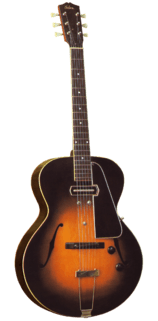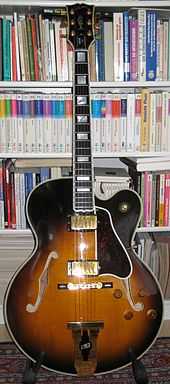Gibson Guitar Corporation
 | |
| Type | Private |
|---|---|
| Industry | Musical instruments |
| Founded | 1902,[1] Kalamazoo, Michigan |
| Founder(s) | Orville Gibson |
| Headquarters | Nashville, Tennessee, USA |
| Area served | Global |
| Key people | Orville Gibson, Ted McCarty, Les Paul, Seth Lover |
| Subsidiaries |
Aeolian Baldwin Chickering Electar Epiphone Garrison Gibson Amphitheatre Hamilton Kramer KRK Systems Maestro MaGIC Slingerland Steinberger Tobias Valley Arts Guitar Wurlitzer |
| Website | Gibson.com |
Gibson Guitar Corporation is an American maker of guitars and other instruments, now based in Nashville, Tennessee. Orville Gibson founded the company in 1902 as "The Gibson Mandolin-Guitar Mfg. Co., Ltd." in Kalamazoo, Michigan to make mandolin-family instruments.[1] Gibson invented archtop guitars by constructing the same type of carved, arched tops used on violins. By the 1930s, the company was also making flattop acoustic guitars, as well as one of the first commercially available hollow-body electric guitars, used and popularized by Charlie Christian. It was bought by Chicago Musical Instruments in 1944, which was then acquired by the E.C.L. conglomerate that changed its name to Norlin Inc. Many observers see this as the beginning of an era of mismanagement.
Gibson sells guitars under a variety of brand names[2] and builds one of the world's most iconic guitars, the Gibson Les Paul. Many Gibson instruments are highly collectible. Gibson was at the forefront of innovation in acoustic guitars, especially in the big band era of the 1930s; the Gibson Super 400 was widely imitated. In 1952, Gibson introduced its first solid-body electric guitar, the Les Paul which became its most popular guitar to date— designed by Ted McCarty and Les Paul. After being purchased by the Norlin corporation in the late 1960s Gibson's quality and fortunes took a steep decline until early 1986, when the company was acquired by its present owners. Gibson Guitar is a privately held corporation owned by its chief executive officer Henry Juszkiewicz and its president David H. Berryman.
History
Early history

· 1920 F-4
· 1917 H-2
· 1924 K-4 mando-cello

(pre 1910)
Orville Gibson (born 1856) patented a single-piece mandolin design in 1898 that was more durable than other mandolins and could be manufactured in volume.[3] Orville Gibson began to sell his instruments in 1894 out of a one-room workshop in Kalamazoo Michigan. In 1902 Gibson Mandolin-Guitar Mfg. Co, Ltd. was incorporated to market the instruments. Initially, the company produced only Orville Gibson's original designs.[4] Orville died in 1918 of endocarditis (inflammation of the inside lining of the heart chambers and valves).[3] The following year the company hired designer Lloyd Loar to create newer instruments.[4] Loar designed the Gibson F5 mandolin that was introduced in 1922, before leaving the company in 1924.[5] In 1936 Gibson introduced their first "Electric Spanish" model, the ES-150 followed by other electric instruments like steel guitars, banjos and mandolins.
During World War II, instrument manufacturing at Gibson slowed due to shortages of wood and metal. Instead, Gibson made wood and metal parts for the military. In 1944 Gibson was purchased by Chicago Musical Instruments. The ES-175 was introduced in 1949. Gibson hired Ted McCarty in 1948, who became President in 1950. He led an expansion of the guitar line with new guitars such as the "Les Paul" guitar introduced in 1952 and designed by Les Paul. The Les Paul was offered in Custom, Standard, Special, and Junior models.[6] In the mid-50s, the Thinline series was produced, which included a line of thinner guitars like the Byrdland. The first Byrdlands were slim, custom built, L-5 models for guitarists Billy Byrd and Hank Garland. Later, a shorter neck was added. Other models such as the ES-350T and the ES-225T were introduced as less costly alternatives.[7] In 1958, Gibson introduced the ES-335T model. Similar in size to the hollow-body Thinlines, the ES-335 family had a solid center, giving the string tone a longer sustain.
In the 1950s, Gibson also produced the Tune-o-matic bridge system and its version of the humbucking pickup, the PAF ("Patent Applied For"), first released in 1957 and still sought after for its sound.[citation needed] In 1958, Gibson produced two new designs: the eccentrically shaped Explorer and Flying V. These "modernistic" guitars did not sell initially. It was only in the late 1960s and early 70s when the two guitars were reintroduced to the market that they sold well. The Firebird, in the early 60s, was a reprise of the modernistic idea, though less extreme.
Modernization
In the late 50s, McCarty knew that Gibson was seen as a traditional company and began an effort to create more modern guitars. In 1961 the body design of the Les Paul was changed due to the demand for a double-cutaway body design.[8] The new body design then became known as the SG (for "solid guitar"). The Les Paul returned to the Gibson catalog in 1968.
On December 22, 1969 Gibson parent company, Chicago Musical Instruments, was taken over by a South American brewing conglomerate, E.C.L. Gibson, Inc. remained under the control of CMI until 1974, when it became a subsidiary of Norlin Musical Instruments (a member of Norlin Industries - named for ECL president Norton Stevens and CMI president Maurice Berlin). This began an era characterized by corporate mismanagement and decreasing product quality.



Between 1974 and 1984 production of Gibson guitars was shifted from Kalamazoo to Nashville, Tennessee. The Kalamazoo plant kept going for a few years as a custom-instrument shop, but was closed in 1984; several Gibson employees led by plant manager Jim Duerloo established Heritage Guitars in the old factory, building versions of classic Gibson designs. The company was within three months of going out of business before it was bought by Henry E. Juszkiewicz, David H. Berryman, and Gary A. Zebrowski in January 1986.[9] New production plants were opened in Memphis, Tennessee, as well as Bozeman, Montana. The Memphis facility is used for semi-hollow and custom shop instruments, while the Bozeman facility is dedicated to acoustic instruments.[10]
In 1977 Gibson sued Hoshino/Elger for copying the Gibson Les Paul.[11] In 2000, Gibson sued Fernandes Guitars in a Tokyo court for allegedly copying Gibson designs. Gibson did not prevail.[12] Gibson also sued PRS Guitars in 2005, to stop them from making their Singlecut model. The lawsuit against PRS was initially successful.[13] However, the United States Court of Appeals for the Sixth Circuit reversed the lower court decision and ordered the dismissal of Gibson's suit against PRS.[14]
Recent history
Gibson purchased Garrison Guitars in 2007.[15] In mid 2009 Gibson reduced its work force to adjust for a decline in guitar industry sales in the United States.[16]
In 2011, Gibson acquired the Stanton Group, including Cerwin Vega!, KRK Systems and Stanton DJ. Gibson then formed a new division, Gibson Pro Audio, which will deliver professional grade audio items, including headphones, loudspeakers and DJ equipment.[17]
Gibson's factories were raided in 2009 and 2011 by the police under the authority of United States Fish and Wildlife Service. In 2009 authorities found ebony wood from India they claimed had misleading labels to hide violations of Indian export law. Gibson claimed the labels were made by mistake.[18][19][20] A second raid was conducted in August 2011, but the details were not released due to ongoing legal proceedings.[19]
Gibson Guitar Corp. filed a motion in January 2011 to recover seized materials and overturn the charges, which was denied by the court.[21][22][22] The Justice Department found emails from 2008 and 2009 discussing plans to harvest endangered ebony wood from Nagel, Germany, in violation of Madagascar's export laws. It filed a civil proceeding.[23][24][25] Gibson argued in a statement the following day that authorities were "bullying Gibson without filing charges" and denied any wrongdoing.[26][27]
The case was settled on August 6, 2012, with Gibson admitting to violating the Lacey Act and agreeing to pay a fine of $300,000 in addition to a $50,000 community payment. Gibson also forfeited the wood seized in the raids, which was valued at roughly the same amount at the settlement.[28][29] The case raised concerns for musicians who lack documentation of vintage instruments made of traditional, non-sustainable materials.[18][30] However, officials from the Justice Department and the U.S. Fish and Wildlife Service have stated that musicians who unknowingly possess instruments made from illegal wood would not be treated as criminals.[31] After a scandal involving the IRS allegedly targeting Republican-backed Tea-Party groups, Gibson's CEO reiterated allegations that the company was unfairly targeted due to political donations the organization made to Republican candidates.[32][33]
Gibson announced a partnership with the Japanese-based Onkyo Corporation in 2012. Onkyo, known for audio equipment and home theater systems, became part of the Gibson Pro Audio division.[34]
Instruments
Gibson also owns and makes instruments under brands such as Baldwin,[2] Epiphone,[35] Kalamazoo,[36] Kramer,[37] Maestro,[38] Slingerland,[2] Steinberger,[39] Tobias,[40] Valley Arts[citation needed] and Wurlitzer.[2]
Gibson makes authorized copies of its most successful guitar designs. They are less expensive than those bearing the Gibson name. A former competitor, Epiphone was purchased by Gibson and now makes competitively priced Gibson models, such as the Les Paul, sold under the Epiphone brand,[41] while continuing to make Epiphone-specific models like the Sheraton and Casino. In Japan, Orville by Gibson once made Gibson designs sold in that country.[42] Gibson has sought legal action against those that make and sell guitars too-similar to their own.
In 1977, Gibson introduced the serial numbering system in use until 2006.[43] An eight-digit number on the back shows the date when the instrument was produced, where it was produced, and its order of production that day (e.g., first instrument stamped that day, second, etc.).[44] As of 2006, the company used seven serial number systems,[43] making it difficult to identify guitars by their serial number alone.[43][44] and as of 1999 the company has used six distinct serial numbering systems.[44] An exception is the year 1994, Gibson's centennial year; many 1994 serial numbers start with "94", followed by a six-digit production number[citation needed]. The Gibson website provides a book to help with serial number deciphering.[44]
In 2006 Gibson introduced a nine-digit serial number system replacing the eight-digit system used since 1977, but the sixth digit now represents a batch number.[43]
In 2003,[45] Gibson debuted its ethernet-based[46] communications protocol, MaGIC, which it developed in partnership with 3COM, Advanced Micro Devices, and Xilinx.[45] Replacing traditional analog hook-ups with a digital connection that would, "...satisfy the unique requirements of live audio performances," may have been the goal of this project.[46]
This system may require a special pickup,[45] but cabling is provided by standard Cat-5 ethernet cord.[45][46]
The Gibson "self-tuning guitar", also known as a "robot model", an option on some newer Les Paul, SG, Flying V and Explorer instruments, will tune itself in little more than two seconds using robotics technology developed by Tronical GmbH.[47]
See also
- David Harvey (luthier)
- Jim Triggs (luthier)
- List of Gibson players
Footnotes
- ↑ 1.0 1.1 "Gibson History". Gibson Corporate Press Kit. Gibson Guitar Corp. Retrieved 20 May 2012.
- ↑ 2.0 2.1 2.2 2.3 Gibson Guitar embraces China, Latin markets reuters.com, Mon Apr 9, 2007 12:07am EDT
- ↑ 3.0 3.1 "Orville H. Gibson, 1856—1918". Siminoff.net. Retrieved 2011-01-28.
- ↑ 4.0 4.1 "Gibson Dusk Tiger". Gibson.com. 2008-06-24. Retrieved 2011-01-28.
- ↑ Wheeler, Tom. American Guitars. HarperCollins. 1992.pp 100—1 ISBN 978-0-06-273154-8
- ↑ Hembry 2007, p. 74—85
- ↑ Duchossoir, Andre. Gibson Electrics:The Classic Years. Hal Leonard Corp. 1998 pp 55—62
- ↑ Hembry 2007, p. 110
- ↑ Hembry 2007, p. 306
- ↑ Gleick, James (1987). Chaos: Making a New Science. New York: Penguin.
- ↑ Fjestad, Zachary (June 16, 2010). "Ibanez "Lawsuit Era" Les Paul Custom Copy". Premier Guitar.
- ↑ "Northwestern Journal of Technology and Intellectual Property | Vol 4 | Iss 2". Law.northwestern.edu. 2010-08-19. Retrieved 2012-05-09.
- ↑ Gibson Guitar Corp. v. Paul Reed Smith Guitars, L.P., 325 F. Supp. 2d 841 (M.D. Tenn., 2004)
- ↑ Gibson Guitar Corp. v. Paul Reed Smith Guitars, LP, 423 F.3d 539 (6th Cir. 2005).
- ↑ Garrison Guitars sold to Gibson thetelegram.com, July 4th, 2007
- ↑ Email, published by Walker Duncan (2009-03-23). "Sources: Gibson adds to layoff tally | Make and Buy | NashvillePost.com: Nashville Business News + Nashville Political News". NashvillePost.com. Retrieved 2011-01-28.
- ↑ "Gibson Guitar increases high-tech lineup with purchase". Tennessean.com. 2011-12-06. Retrieved 2011-12-06.
- ↑ 18.0 18.1 Felten, E. (26 August 2011). "Guitar frets: Environmental enforcement leaves musicians in fear". The Wall Street Journal. Archived from the original on 1 September 2011. Retrieved 1 September 2011.
- ↑ 19.0 19.1 Wadhwani, A.; Paine, A. (25 August 2011). "Gibson Guitar raided but lips zipped". The Tennessean. Archived from the original on 26 August 2011. Retrieved 26 August 2011.
- ↑ Lind, J.R. (29 December 2010). "Federal agent: Gibson wood investigation likely to result in indictments". NashvillePost.com. Archived from the original on 10 July 2011.
- ↑ "Update: CEO's Outrage Gets Media Buzzing". Gibson Guitar Corp. 26 August 2011. Archived from the original on 1 September 2011. Retrieved 1 September 2011.
- ↑ 22.0 22.1 "Gibson Guitars fails to squash illegal wood investigation". Sound & Fair. 19 January 2011. Archived from the original on 1 September 2011. Retrieved 1 September 2011.
- ↑ "Gibson/Lacey Act Update". Home Furnishings Business. 6 July 2011. Archived from the original on 10 July 2011.
- ↑ "Endangered species trafficking: What did Gibson Guitar know?". mongabay.com. 7 July 2011. Archived from the original on 23 August 2011. Retrieved 23 August 2011.
- ↑ Trotter, J. (25 August 2011). "Endangered lemurs could be connected to Gibson raid". WMCTV.com. Archived from the original on 26 August 2011. Retrieved 26 August 2011.
- ↑ "Gibson Guitar Corp. responds to federal raid". Gibson Guitar Corp. 25 August 2011. Archived from the original on 1 September 2011. Retrieved 1 September 2011.
- ↑ Stern, Andrew (25 August 2011). "Gibson Guitar to fight U.S. probe of its wood imports". Reuters. Archived from the original on 1 September 2011. Retrieved 1 September 2011.
- ↑ Black, R. (6 August 2012). "Gibson settles discord on timber". BBC News. Archived from the original on 7 August 2012. Retrieved 6 August 2012.
- ↑ Clarke, C.; Grant, A. (4 May 2011). "Are your wood products really certified?". wri.org. Archived from the original on 23 August 2011. Retrieved 23 August 2011.
- ↑ Simmons, L. (31 August 2011). "Raid highlights music manufacturers' environmental risks". bizmology.com. Archived from the original on 1 September 2011. Retrieved 1 September 2011.
- ↑ Eilperin, J. (13 November 2011). "Gibson Guitar ignites debate over environmental protections". Washington Post. Archived from the original on 16 November 2011. Retrieved 16 November 2011.
- ↑ "Gibson CEO revives complaints over government raids in wake of IRS scandal". Fox news. May 29, 2013.
- ↑ "Now The Gibson Guitar Raids Make Sense". Investor's Business Daily. 23 May 2013.
- ↑ "Gibson Expands Pro Audio Division". Gibson.com. 2012-01-04. Retrieved 2012-02-09.
- ↑ "Home". Epiphone. Retrieved 2012-05-09.
- ↑ "Gibson Kalamazoo". January 2, 2009.
- ↑ kramerguitars.com Kramer Official Site
- ↑ Maestro by Gibson Gibson Official Site
- ↑ steinberger.com Steinberger Official Site
- ↑ Tobias Gibson Official Site
- ↑ "Epiphone Les Paul Standard". Epiphone.com.
- ↑ "Epiphone: A History — Epiphone and Gibson". Epiphone.com.
- ↑ 43.0 43.1 43.2 43.3 Gibson Serial Numbers: What a serial number can and can't tell you about your Gibson Gibson Official Site, 7.17.2007
- ↑ 44.0 44.1 44.2 44.3 Blue Book of Electric Guitars. Sixth Edition: Gibson Serialization. Edited by S.P. Fjestad Gibson Official Site
- ↑ 45.0 45.1 45.2 45.3 The MaGIC of Gibson's Digital Guitars Maximum PC magazine, April 2003
- ↑ 46.0 46.1 46.2 This Is MaGIC Gibson Official Site
- ↑ Yuri Kageyama (The Associated Press) (December 3, 2007). "World's first robot guitar takes care of the tuning". Seattle Times. Retrieved 2007-12-04.
References
- Hembry, Gil (2007). Gibson Guitars: Ted McCarty's Golden Era 1948—1966. Austin, TX: GH Books.
External links
| Wikimedia Commons has media related to Gibson guitars. |







.png)







